Prehistory
Nine thousand years ago, the lands of eastern Ontario emerged from the glacial waters of the Champlain Sea. The sea drained away to the Atlantic and the water flow switched from the Ottawa River Valley to the Great Lakes and the St. Lawrence Valley. Eastern Ontario began its modern history.Plants, birds and animals invaded the old sea floor. Tundra type plants spread from the beaches and small islands that dotted the sea. The aboriginal people moved onto the large clay flats and gravel ridges. The South Nation River drained the valleys.
As the climate warmed, coniferous trees, the softwoods, appeared bringing with them freshwater life. Over the next millennia deciduous trees, the hardwoods, arrived.
By two thousand years ago the climate and environment were similar to today. The river was already aged, with numerous oxbows and wetlands where layers of peat had been laid down. The land, air and water supported a wide range of plants, animals, fish and birds.
The aboriginal population was also growing. They were hunters and gatherers who developed tools and utensils using stone, wood, and bone. Clays were used to make pottery.They also imported shell, copper and skills.
Arrival of Agriculture
One thousand years ago the native peoples, south west of Chesterville, began to grow corn, beans, squash, sunflower, artichokes and tobacco. Their crops supported settled communities and trade with neighbours.The St. Lawrence Iroquois lived in communities of up to 3000 people. It was a matriarchal society led by clan mothers and about 12 families lived in each longhouse. The houses were protected by a log palisade. One such site was east of Oak Valley near the corner of Pemberton Road and Sandy Row.
They located their villages by water, next to wetlands and large fields. The former provided fish, shell fish, plants and some security. The forests and meadows provided deer and other animals plus plants, wood, nuts and fruits. The fields were cleared and planted in crops. The residents lived a relatively comfortable life with a diverse diet.
About 1550, the St Lawrence Iroquois died out, probably from European diseases. Farming ended at Oak Valley for 200 years.
Early Settlement
After 1783, the United Empire Loyalists, Americans of English, Scots, Irish, German (Hessian) and Palatine origins, settled on the St Lawrence Front. Succeeding generations spread inland. Initial land grants made to UEL families were often sold to American and British settlers after 1800.Mountain Township was surveyed about 1793 and named for Bishop Jacob Mountain. Several nearby lots were reserved for the established church and Kings College. Early settlers included the Hyndman, Bigford, Armstrong and Baldwin families.
Benjamin Bigford acquired an interest in lot 18 in concession 1 of Mountain Township near the Forks in 1814 while he was serving with the county militia as part of the war of 1812. Pressures were already building to clear and settle land in the middle and back of Matilda Township and adjacent Mountain Township.
The need for additional farm land came initially from the descendants of the Loyalists who had settled along the St Lawrence front following 1783. Secondly, there were American settlers like Bigford. Later there were Irish, English and Scottish settlers who arrived after the close of the Napoleonic wars. The new comers arrived along trails from the front, by the river and later the settlement road along the river from Spencerville and finally by trails from Kemptville.
Bigford, like many of his neighbours, probably arrived from Leeds and Grenville by water. He cleared some of the land and drained the swales and bogs, planted wheat, raised beef, lamb and pigs. Like his neighbours he was concerned by high water tables and slow drainage. A wet summer or single heavy downpour could destroy crops and drown livestock.
By 1851 Bigford had cleared half of his acreage and was operating a mixed farm which supported a family of some twelve children, though many were now adults and farming nearby.
Beginning in the 1860's demand for milk began to increase. Industrial production of cheese and butter was beginning and farmers close to rail lines could ship fresh milk to urban centres. These new markets transformed agriculture, resulting in the rapid clearing of farm woodlots to plant corn to feed expanding dairy herds.
The removal of the bush speeded spring thaws and reduced the land's capacity to retain water. Consequently, large quantities of water periodically overwhelmed the narrow channel and filled the river flood plain farms.
The settlers early campaigned for river channelization and for removal of downstream dams. In 1827, the first of many mill dams was built at Armstrong's Mills (Chesterville). In time, these were increased in size and created a head pond that would stretch back 15 miles. Carter on page 74 records that the McOuat, Bigford, Brown, McIntosh and associated families undertook a campaign to remove the dam, channel the river to improve drainage and lower the water table. They hoped that this would save their crops and livestock from the consequences of the high water table, the frequent flooding following summer deluges, and the problems of sowing and harvesting on the cool water saturated soils.
About 1900, farm (municipal) drains were constructed across the fields to improve drainage. This further concentrated the flow into the river after summer storms and the spring thaw. This effect was increased even more with the installation of tile drainage in the fields.
The Chesterville dam was essential to the village's economy: grist and saw mills, carding and fulling, and tanning plants. The mills in time, switched to steam power. Water continued to be required by the steam driven railway, by the Refrigerator or cold storage plant which collected and exported eggs, fowl and other produce, and subsequently by the Condensory and milk processing company. Consequently the dam became larger rather than being removed.
Initial Planting
In 1980, the river was channelled from Chesterville to the Forks. The work cut off the oxbows and promoted the increased flow of water. To bypass an oxbow west of the Forks, a channel was cut across the southern portion of lot 18. The channelization required removing the Bigford farm house. The barns and machinery buildings had collapsed into piles of rubble and remained to the north of the new channel.The new channel cut off a small triangle from a larger cultivated parcel, leaving a ten acre rump beside the barnyard north of the river. The northern boundary of this parcel lay along Baldwin Road, the historic forced settlement road which ran from Spencerville to Chesterville.
After the drainage work was complete, local farmers had no interest in this orphan parcel. However, Irene Woolford was looking for a place to plant black walnut seed which she had collected during a visit to a friend. She mentioned this to Larry Grey, then a director with the South Nation River Conservation Authority, and he pointed her to the Authority's administration. They approved her proposal.
The soil on the Bigford parcel was severely compacted by the construction equipment and proved to be a challenge to work up. Irene recalls: "Oak Valley was just a scene of bare earth with a few weeds growing here and there, when I first saw it. Coming from the city, I did not know anything about acreages, so I thought it mighty small for ten acres. I would fill that in no time."
"Ha! I got two rows of seeds planted and left them to do their 'thing'. The next year a number came up but it was not until the third year that almost all germinated. In the meantime the weeds grew too - overtaking the seedlings in height, so the second year was a big weeding chore."
Irene had joined the Society of Ontario Nut Growers and mentioned to members that she needed help transplanting her seedlings. "And the third year, I had the good luck to have members of the Eastern Chapter, the Society of Ontario Nut Growers to help transplant the seedlings into the field."
"South Nation Conservation encouraged the project and planted the former arable portion mostly in white pine. The pines acted as windbreaks to the seedlings which were transplanted between the rows of pines. Now I figured it was the time to relax and let the trees grow. Not so, they needed TLC by keeping the weeds and grasses away from the transplants. The weeds block light and the grasses steal nitrogen from the baby trees. The solution was to put carpeting around the seedlings so the shade killed the weeds- yet let water through to the roots." Black Walnut transplants to the east end continued through 1989-90.
The Park Grows
Dr. Ralph McKendry succeeded Irene as chair/leader of the group and brought with him several new ideas, which included developing a comprehensive working plan, creating lanes and walkways, establishing sound funding, and development of the west (barnyard) portion. Spring and fall field days became the norm, with many volunteers stopping by during the summer to fight the weeds and to continue work.McKendry's notes show that a seed nursery was established. They discovered that problems were solved by covering seeds placed in mulch with barn siding sheet metal during the winter. This promoted early sprouting and excluded mice and squirrels. Later seed boxes were used for germination, followed by transplanting the sprouts to a nursery before planting the seedlings out. The initial plantings included black walnuts and oaks.
A vision/work plan was prepared during 1991-92. The parcel was surveyed and laid out in blocks by Ernie Kerr who began to build a data base of trees. 1992-95 was an extremely busy period in the development of the Park. Irene reports that - "I preferred to forget that the next (west) half of the field was a mess of bushy growth and I did not feel able to clear it. Ralph McKendry organized a clearing project - digging machines to get the roots out, and cutters to cut the brush down. In due course, it was bald of vegetation. More planting began - but not just the two varieties I had started, but many other species, including ginkgo and many other kinds of oak."
The clean up continued from 1992-94, removing the Manitoba maples, sumac, perennial weeds, barn refuse and old farm machinery which littered the area. Local farmers such as Franklin Salter brought their tractors with loaders to assist with the clean up. Meanwhile the group continued to fight the wild parsnip and other weeds which grew in the east end, particularly in the lanes and where the pines were not grown enough to crowd them out. Mac Saunders used his bush hog to cut the weeds replacing the initial improvised efforts of Ralph McKendry and George Truscott.
The township installed a culvert and gravelled the entrance way. Twenty catalpa seeds were planted, germinated and with 150 walnuts were transplanted. As the west side was cleaned up the land was disced. Two dug wells near the barns were filled in.
By 1993, the nursery was filled with seedlings and protective snow fencing installed. Ted Cormier, accessing Ontario funding acquired 96 commercial named varieties of trees and some bur and chinquapin oak. Most of these were planted among the pines in the east end and some around the new seed nursery.
The many new species and varieties acquired were Carpathian or English walnuts, hazelnuts, heartnuts, shagbarks, chestnuts, Korean and Siberian Nut pines, northern pecan, horse chestnut, hican and American Chestnut. There were similar test plantings at Baxter Conservation Park, Kemptville, Long Sault Parks on the St Lawrence and at Alfred College.
Work also began on installing a 150 year old rail fence acquired from the Stuart farm in Osgoode Township. Neighbour Norm Tinkler provided a post hole auger to drill the post holes. After the fence was installed, a line of pine trees lifted from the laneways in the east end, was planted along the fence to provide a windbreak.
The same year, three rows of black walnuts raised in the nursery were planted along the west fence line. The Catalpa were transplanted by Kathleen Jones and Myrtle McKendry along the barrow pit or dug pond just south of the rail fence near the gate.
1994 was a year of frantic planting. Some nursery oak were transplanted to the west end and some horse chestnuts transplanted near the entrance way or mid section.
Thirty six caliper trees from Calumet Island were acquired. Twelve white pine were planted along the rail fence to replace trees damaged by voles. Twelve red oak and twelve beech were also planted. Additional named varieties were planted in the east end.
The nut pine orchard was established in the west side. Starting nut pine seedlings in the nursery had not been successful. However grafts of scions on white pine roots stock proved more successful.
Bur oak trees were collected from along side Kirkwood Road and planted along the new entrance way (Oak Lane); six promptly died. The surviving oaks were down to only 2 the following year. Hackberry were also planted on the drive way. South Nation Conservation provided 12 red oaks which were planted along the riverbank. Some black walnuts from the nursery replaced failed trees in the east end and a number were sent to Osnabruck High School.
Site improvements continued, with gravelling of the entrance, Oak Lane and the exit drive. The trails through the pines were levelled. Mac Saunders of Inkerman brought his John Deere tractor and finishing mower to cut the grass and weeds. This reduced competition for the seedlings, ensured continued light and air circulation, thereby boosting their survival rate and encouraging rapid growth.
The Pioneer Memorial
In 1995, over 65 glacial boulders were uncovered when the barn foundations were cleared. These were placed along the driveways and the river bank. Ralph McKendry proposed that the park be dedicated to the pioneer settlers of Eastern Ontario. Bronze plaques would be sold to families of pioneer settlers and placed on the boulders to commemorate their ancestors. The funds raised would be retained and invested for the purpose of providing for perpetual maintenance of the park. Today, many of the visitors to the site are families coming to see the plaques commemorating their ancestors.Irene missed the fall field day in 1995, to attend her wedding to Michael Broad. In her absence, the volunteers named one of the trails in the east end in Irene's honour.
1996 was another busy year of planting out seedlings. Over 300 red oak seedlings were planted out in the west end as well as 150 black walnut and 150 red oak provided by South Nation Conservation. Commercially grown oak were planted along Oak Lane to replace the unsuccessful Bur Oak transplants.
Fifty black walnut and the following year another 200 seedlings were planted on another South Nation Conservation property east along the river at Pemberton Road and Sandy Row. In 2008, the surviving Pemberton Road trees were producing seed. Several black walnut were also planted on the Franklin Salter "school house" property to the east of the Park.
The devastation of a fungal disease on formerly numerous butternut trees, brought Oak Valley volunteers, the Eastern Ontario Model Forest, Ministry of Natural Resources and the Forest Gene Conservation Association together to establish a Butternut Archive at Oak Valley. Scions cut from apparently healthy butternut trees in areas where canker was common, were grafted to black walnut rootstock and planted immediately west of Oak Lane. After 15 years only 6 of the 21 grafts were successful, though the root stock survived in most cases, reverting to black walnut which was seeding by 2008.
In 1997 and 1998, butternut seedlings from seed selected from healthy trees, were started at the Ferguson Forestry Nursery in Kemptville and planted out in the western part of the Archive. These seedlings were very successful with few losses. These are expected to produce seed about 2010.
Trial plantings of nut pine seed were not generally successful. However, grafts of Korean and Siberian nut pines scions to white pine root stock were planted out in 1998. They have been generally successful and produced some seed in 2008. However the trees and root stock grow at different rates so there are many top heavy nut pines rising from slim white pine trunks which are slower growing. These specimens are not likely to survive heavy winds or ice storms in future years.
In 1997, some 40-50 commercially grown bur and white oak caliper trees were planted. Kurt Wasner supplied 10 English Oak from his nursery and these were planted along Oak Lane and near the river bank. The 10 acre site was rapidly filling up and the emphasis began to shift from planting seedlings to protecting and encouraging existing transplants.
In 1998, the last of the major plantings/transplants took place, filling the back of the Butternut Archive, the nut pine planting, and the south west quadrant along the river.
The are now over 25 varieties of tree and nut bearing shrubs planted on the site. The black walnut have done very well, as have the red oak, English oak and bur oak. Hazels have also done very well, around the nursery and the transplants to screen the scrap heap in the west end. ginkgo in the west end have done well. Nut pines have done moderately well. The butternuts have not performed as well as the black walnuts.
Horse Chestnuts have not been successful. Those planted in the mid section have largely died out due to a rust infection which has also wiped out most of the seedlings in the nursery. Buckeye have done much better and in 2008 several produced seed.
The American chestnuts also have not done well. Transplants from the nursery have generally been unsuccessful. Several named varieties were planted in the pines and have not been able to compete with the fast growing pines for light.
Throughout the planting phase there was a constant struggle with Manitoba maples and aggressive weeds such as wild parsnip, thistle and golden rod. Anywhere with good light penetration resulted in an excess of these plants. Vigilance and constant effort was required to clear open areas, around the barn foundations, and the areas around new plantings.
In the east end particularly, the Manitoba maples grew faster than the pines and most of the hardwoods planted among them. Repeated attacks were required to cut and suppress the aggressive plants. A backhoe was used to attack these trees, followed later by chain saws, chippers and herbicide. In more recent years ash have become more invasive in the east end with many cut in 2004 and 2005.
Control of the aggressive weeds was easier in open areas because the grass was cut routinely beginning about 1995. However on the margins of the fields, and in the east end amongst the pines they remained a problem, especially where pines and seedlings intermingled.
The weed problem was solved manually by use of a scythe, freeing up the seedlings until they were tall enough to overreach the weeds which in turn cut off the light to the weeds.
1998 also marked a turning point in the leadership of the volunteers. The early group consisted of Irene Woolford, Ralph and Myrtle McKendry, Ernie Kerr, George Truscott, Len and Genice Collett, Alex and Kathleen Jones, Ted and Isabel Cormier, and Mac Saunders. In 1998, Ralph McKendry and Mac Saunders both died.
A new group began to come to the fore. Peter Carr succeeded Ralph McKendry as group leader. Gord Bartholomew and Buck Cairncross took over mowing of the grass. They were later succeeded by Gord's grandsons Scott and Tory Baldwin. Other volunteers included Kim Baldwin McInnis and her husband Lester who developed and built the Victorian flower gardens in the base of the silos and around the nursery. Rob Saunders involvement was short lived due to his too early death. His wife Jo continues to be active.
Other new faces included John Sankey, chair of ECSONG; Robert McKendry who continues his family's involvement; John Adams who has picked up Ernie Kerr's surveying of land, trees and building of the tree data base. Murray Inch would succeeded the Baldwin's in mowing of lawns and scything weeds. He later succeeded Peter Carr. Roman Popadiouk brought his international forestry training to the Park and with it some additional specimens. Other names are the Metcalfe's, Jo-Anne, Cliff and Hugh, Debbie Decooman and family, Bart Steele, and Nick Zrymiak.
Throughout the development phase, Josée Brizard, a forester, was South Nation Conservation's (SNC) supportive representative/liaison person. She continued to play this role when she moved into management responsibilities with the authority.
A great deal of credit for facilitating progress was due to Josée's active involvement and enthusiastic support in creating this facility. SNC also maintains the records of the families who purchase commemorative plaques at Oak Valley.
1999 Activities
In 1999, the park vision statement and working plan were updated. The focus changed from establishing a plantation, to developing a science based arboretum and public recreation park. A business plan was prepared at the request of the SNC Board of Directors, and an application was made to the Ontario Trillium Foundation for funding to speed up development of the Park. The application was not successful.However the work involved in updating the vision and developing the business plan led to a formal agreement between South Nation Conservation and The Society of Ontario Nut Growers. It recognized that the volunteers were responsible for managing and operating the park. The volunteers also have a right of first refusal should SNC ever dispose of the property.
Under Peter Carr's leadership, in addition to the above, a shelter was constructed; an outhouse was installed; the Victorian Garden's were worked up and planted; the struggle to eradicate Manitoba maples and to suppress weeds was largely successful, and walnut seedlings were provided for the Gypsy Lane Trail between Winchester and Chesterville.
At this same time, John Adams began to build the computerized data base of the trees; the 1993 planting of named varieties was surveyed, as was the Butternut Archive. Trees from the nursery were sold to raise funds; and a cairn was constructed to commemorate the pioneer settlers.
2000 Activities
In 2000, Kim and Lester McInnis undertook the creation of the Victorian Gardens, including adding flowers to the west and north sides of the nursery. Brian Henderson supplied 6 ginkgos which were planted in the south west side of the park. Kurt Wasner replaced two dead bur oaks along Oak Lane. George Truscott provided Shagbark hickory seedlings plus bur oak, English oak, Kentucky coffee trees, butternut and chestnuts. Ted Cormier provided seeds of beaked hazels, red oak, American hazel and white swamp oak.In July 2000, the South Nation Conservation Board of Directors came for their summer meeting and luncheon. In August 2000, South Nation Conservation held a Volunteers and Pioneer families day at the park. A sign marking the Heritage function of the Park was unveiled by Myrtle McKendry and Mary Ann Wilson of SNC. Pat Coyne spoke about the history of the region and a lunch was served.
In the fall of 2000, many pines were cut to increase light to under-planted hardwoods.
2001 Activities
In 2001, many seedlings in the nursery were lifted for sale, some by parents of students at Nation Valley school. A major effort was made with SNC assistance to cut and treat Manitoba maples and chip the wood. The shelter, built with financial assistance by the Royal Canadian Legion, was installed. The National Defence Fish and Game Club which undertook a project to promote fish spawning in the remains of the old oxbow, built the viewing platform in the south west corner of the Park. Land Stewardship Program youth helped with maintenance work during the summer, including weeding the gardens and Nursery. Peter Carr stepped down as group coordinator at the end of the year.
2002 Activities
In 2002, the year started sadly with Rob Saunders sudden death, which occurred shortly before his much anticipated retirement from teaching. 56 black walnut, 25 swamp white oak and 30 American hazel were delivered to Dolman Ridge and 3 Wisconsin butternut secured in return. Seedlings were also provided to SNC for sale to the public as a fund raiser. The hazels were especially popular with the public. Some hazels were planted as a screen in the south west corner of the park.A lot of general maintenance was done at the park this year. The trees despite plentiful rain, were showing stress after the near drought conditions in 2001; fungal problems developed with the humidity, plus an excess of tent and other caterpillars. The nut crop was very small. Some assistance was secured from a SNC work crew, who also took out a dead elm, and a Human Resources youth employment crew did several days maintenance work on the site. Two black walnut trees were provided to North Dundas Township for Chesterville Park.
2003 Activities
2003 started off with group members called to North Dundas Township Council on April 28. They were presented with certificates from the Ontario Heritage Foundation and the Township Council, recognizing the work of the group in creating the Oak Valley Pioneer Park. As a result Oak Valley received good coverage in the Winchester Press, Chesterville Record and the Eastern Ontario AgriNews. Eastern Chapter, Society of Ontario Nut Growers (ECSONG), recognized Peter and Sheila Carr and John Sankey for their work at Oak Valley and Dolman Ridge Nut Groves.Seedlings were again lifted for sale through SNC for fund raising. Field days were held in June and September and focussed on general maintenance, and suppression of weeds and weed trees. Meanwhile the trees recovered from the drought conditions of 2001, put on good growth.
To mark the 25th anniversary of ECSONG, a history focussed edition of the Nuttery was published in December 2003. It contained several articles about Oak Valley: An obituary-tribute to Clarence Cross, the historian/genealogist who had served as historian for the Pioneer Memorial Plaques program at Oak Valley; Oak Valley Nut Grove Genesis by Irene and Michael Broad; Creation of the Oak Valley Plantation and Arboretum by Murray Inch; Future Vision for Oak Valley Nut Grove and Pioneer Memorial, by Murray Inch; and ECSONG Onward and Upward by Kim and Lester McInnis.
2004 Activities
2004 started off with transplant day April 25 when walnuts, catalpas and hazels were lifted for sale and some hazels for transplant to the south west corner. George Truscott donated honey locust, hazel, oak and walnut trees to the sale. Spring field day in June cut branches on pines to increase light and air circulation, cleaned up nursery and flower gardens, updated the survey of 1993 cultivars in the east end, and updating the tree survey data base. Murray Inch reached an agreement with SNC about taking over grass cutting at the Park.The number of visitors increased this summer due to publicity we have been receiving and the fact the park is now being shown on some tourist maps.
This was another summer with lots of rain so the trees experienced excellent growth. Fruiting was moderate after several disappointing years. Control of park weeds continued but was accomplished in half the time of previous years indicating the trees now had the upper hand.
Shagbark plantings from 2002 and 2003 in the Truscott Nursery were inexplicably lost. Attendance at the fall field day was very low. George Truscott indicated that the drive from Calabogie was becoming a challenge and asked for someone to take over the ongoing duties in the Nursery.
Some of the volunteers visited the Long Sault planting of named varieties that were planted in 1993. It is similar to the planting at Oak Valley made that same year. At Oak Valley 52 of the 96 trees and shrubs planted survived while over 40 of the 63 trees and shrubs survived at Long Sault.
The Long Sault planting suffered from the numerous deer who have no predators. As a result, all the Long Sault hazels, were destroyed. The American chestnut mostly survived but were cropped to 3 feet high as were most of the Persian and Carpathian walnut, butternut, heartnut, hickory and buartnut. Black walnut, one chestnut, some butternut and one hican constituted the bulk of trees which survived and have grown beyond the reach of the deer.
A presentation was made to North Dundas Township Council on November 22, 2004 explaining the goals and development of the Park and requesting an operating grant for 2005. This was adopted so the financial position was strengthened with operating grants from SNC and the Township.
2005 Activities
In 2005, transplant day was held April 24, with black walnut, hazels, honey locust and oak delivered to SNC for sale. Seedlings were also donated by John Adams, Len Collett and George Truscott, and some stock was started on an adjacent property by Murray Inch. Seedlings were also donated to Inkerman public school and planted by students, but were lost during the zealous cutting of the grass. Seedlings were also provided to the Ottawa Urban Forest Project in Alta Vista and to McIntosh Community Park in Berwick.Spring Field Day was held May 14 with a good turnout. While parsnip and similar weeds were coming under control, invasive species such as buckthorn, plus grape vine, Virginia creeper and poison ivy had begun to show up in the Park.
The focus in operating the park had clearly changed. While field days continued to be held, more of the maintenance of the lawns, flower gardens, trees etc are done on an ongoing basis over the summer. With public support we also recognize that passive recreation opportunities must be developed as well as education programs.
The survey of trees in the east end was begun.
The spectacular growth of trees has reached sufficient size many over 25 feet, that culling of trees must begin. The seedlings had been planted on as little as 10 foot centres, and expanding crowns have shaded out the grass and is affecting neighbouring trees. The cull is necessary to ensure that remaining trees have sufficient space so they are self supporting, and there is sufficient air and light available to develop healthy stock.
Seedlings started at the Central Experimental Farm from seed from the Ukraine were planted in the extreme west side near the ginkgos and south of the black walnut orchard rows.
The seedlings included English or Carpathian walnut, Mongol oak, English oak and horse chestnut. The horse chestnut quickly succumbed to the fungus which killed most of the native plants at the site. Len Collett supplied Levant Township Shagbark Hickory seedlings, and John Sankey supplied some black and white oak seedlings.
This was also the year that erosion of the river bank became a serious problem, with large sections of the bank slumping into the river channel during spring freshette.
In June 2005, some of the Volunteers: Kim and Lester McInnis, John Sankey and Murray Inch visited the Long Sault Park with the named tree varieties . John Sankey led the group in preparing a GPS based plan. Everyone helped to create tree guards of fence wire and chicken wire to protect the over browsed trees. A lot of invasive sumac and buckthorn was cut back. In late 2008, most of these trees had developed a strong base and were poised to grow beyond the guards.
As part of out reach to the public, the brochure concerning the Memorial Plaques project was revised, and two new brochures concerning the history of the park, and the park as a public resource were drafted. An Oak Valley page was added to the SNC website. There was also study of improving the signage for the Park and some local sign stands were acquired.
Volunteers made presentations about Oak Valley and the region to the Chesterville and District Historical Society and a visiting tour group from Ottawa.
The year was disappointing as the longstanding relationship with ECSONG broke down. Many volunteers left the increasingly unstable organization and some members were barred from its affairs.
The erosion of the river bank continued with additional sections of the bank slumping into the river channel during spring freshette.
2006 Activities
In March 2006, a report was made to the Township Council and a request for an operating grant was made. This request was approved.In March, a Conservation Group from Manitoba on a fact finding tour visited Oak Valley and were briefed on the role of volunteers and community members in delivery of South Nation Conservation programs. The topics included development and management of Oak Valley Pioneer Park while Norm Tinkler talked about farmers' involvement in delivery of farm conservation programs.
Due to the collapse of the relationship with ECSONG, the volunteers met, adopted their own constitution, adopted the name Volunteers of Oak Valley Pioneer Park, and elected Murray Inch as president and John Sankey as Secretary. The Park was officially named Oak Valley Pioneer Park.
The letter of understanding between SNC and ECSONG for management of the site had expired and it was replaced by a letter of understanding between SNC and the Volunteers of Oak Valley Pioneer Park. SNC was very supportive during the disruptive period with ECSONG.
Transplant day was held in April and a significant number of trees were sold with the surplus honey locust and pin oak being sold locally. The spring field day was held May 27 and prepared the site for summer visitors. On this day the constitution of the Volunteers was adopted and elections held. North Dundas Councillor Estelle Rose joined the group for lunch.
During the summer, Roman Popadiouk and Sergei Ponomarenko planted an additional 10 Juglans regia (Carpathian walnut) from the eastern Ukraine. Four of these were later transplanted to a clearing in the east end. Five of the remaining 6 which were planted near the top of the river bank in the mid section survived. Roman also planted in the nut pine orchard, two Scots pines started from seed collected in east Russia.
The number of visitors to the park continued to grow. The Chesterville and District Historical Society held a picnic during July followed by talks about the Bigford family and other early settlers. The visit was reported in the Chesterville Record. The brochures drafted the previous year were published and made available to the public through the SNC office, North Dundas Council office the SNC display at local fairs,(Navan, South Mountain, Chesterville, Spencerville and Metcalfe) and in a display at Oak Valley.
A report was made to North Dundas Council and they agreed to provide the operating grant for 2007.
2007 Activities
The year began as with prior years with lifting of seedlings for sale by SNC. This was done as part of its distribution of seedlings purchased by local property owners. Two caliper trees were transplanted to the South Mountain Recreation Park as part of the Library branch construction and improvements to the Park.The park was opened as in recent years for Mothers' Day, and the field day was held June 9. The day consisted of general cleanup and routine maintenance. Trimming of the pine tree branches on the lanes in the east end improved public access. General maintenance and grass cutting continued over the summer and John Adams paid visits to continue the tree tagging and building the tree data base for the east end.
Visitors reached an estimated 400, over the summer and visits continued late into the fall due to the good weather. The Chesterville and District Historical Society held its visit during August. History talks touched on the naming of Oak Valley, previously the Forks, the Bigford and Fralick families, the Chesterville mill, and the Victorian Flower Gardens. Several volunteers are also part of the North Dundas History Stewards a group promoting local history and culture, thus raising the profile of the Park.
Brochures were distributed as in previous years, and at the Chesterville farmers market. Irene Broad made two well received presentations about Oak Valley to The Riverside Women's Institute and the Winchester Women's Institute.
2008 Activities
Transplants were lifted in April for sale by South Nation Conservation. Sales were down this year even though South Nation bought a selection for landscaping their new office site. Some local sales and a number were given to neighbours who had helped out on field day. Debbie Decooman also sold many ginkgo seedlings which she acquired from George Truscott and donated the proceeds to Oak Valley.Summer operations began on Mother's day. Spring field day was held on June 21, and the main focus was on rebuilding the cedar rail fence. Fence work continued over the summer with the assistance of Richard Huyda and Adam Inch from Ottawa, and finished up on October 18, the fall field day. SNC supplied a power post hole auger as a tractor and mounted auger could not get through the pine trees to the fence line. Thinning of the pines continued and the flower gardens were prepared. Irene Broad trimmed the oaks.
There was again a steady stream of visitors especially on the weekends, although some came to enjoy a quiet lunch or evening respite. The Chesterville and District History Society and the North Dundas History Stewards came in August for their annual picnic and discussion of local history. This year the topic was the grist and saw mills of Inkerman with discussions led by Kim McInnis and Murray Inch.
Due to the frequent rains the lawns required frequent cutting over the summer and the trees grew very well. Seed production was small: primarily walnut, oak, some nut pine, and hazels. Aided by the weather conditions the Victorian Flower gardens were outstanding, particularly in July.
The Volunteers took part in the butternut recovery project, with ten butternut seedlings planted at Sandy Row and Pemberton. Others were planted on volunteers properties throughout North Dundas. The coordinator of the butternut recovery project Rose Fleguel, visited Oak Valley to review the trees in the archive.
The volunteers led by Kim and Lester McInnis took part in the Open Doors Project on September 7. Kim developed a new brochure for visitors which we hope to print and use widely in 2009.
Fall field day completed the reinstallation of the cedar rail fence and gate posts. Barclay Cormack, a SNC Board member led the group in thinning the pines. Some discussion was given to improvements, including a shelter for picnic tables and barbecue units. Also being considered are gravelled paths and caps for the silo foundations. The future of the Truscott nursery is also under review.
The annual report was made to North Dundas Township Council, SNC and to members and a request made for continuation of operating grants for 2009.
2009 Progress
Operating funding was contributed by SNC, North Dundas Council, the sale of seedlings, and donations for the long term maintenance of the park. The summer started well, but heavy rains arrived in June and continued into July. Growth of trees and grass was strong. There was almost no seed produced by the walnuts, oaks, just a little buckeye and hazel. Field days were held on May 30 and October 17. Thinning of the east end pines continued, with the help of Barclay Cormack.In addition to the usual field day activities in October, we started the rehabilitation of the main sign, and about thirty red oak were culled.
Because of the weather the number of people coming to picnic declined. One of the two barbecues was installed with second deferred until 2010. Consideration continues concerning building a larger shelter and other improvements to the Park.
A new group of visitors, participants in geocaching came in significant numbers since the park was been listed on the Geocache.com website. A geocache event is planned to open the season in April 2010.
A Tri-Valley Conservation certificate was awarded to the Volunteers for their contribution to rural conservation. The awards are granted by the Mississippi, Rideau Valley and South Nation Conservation Authorities.
With the arrival of the bi-centennial of the war of 1812, we are exploring activities that will feed off tourist funding and bring greater recognition of the Park, in the community.
2010 Season
South Nation Conservation and North Dundas Council both approved operating grants for the park.The season formally opened on a surprisingly warm April 24 with a picnic by 52 members of the GeoCachers of Eastern Ontario. (Earlier, MNR had ticketed 2 visitors for fishing out of season.) The grass was again cut for Mother's Day, May 9, the usual opening day for the park but the weather was cold and wet with no visitors a surprising turn of events.
Spring field day was held May 15, over 16 persons turned out to enjoy the fine weather and do a great day's work, trimming trees, repairing the ruts and damages of early spring invading 4 wheelers, reinstalling the entrance way sign, removing more pine in the east end, trimming and removing weeds and tending the flower gardens. At the Annual General Meeting the executive members Murray Inch and John Sankey were continued on for another year. Irene Broad missed the meeting because she had no wheels.
2011 Season
The trees reached a new level of maturity, so culling of the nursery pines and tree stock continued. The final group of seedlings were removed from the Truscott Nursery. This ended a long lasting tradition of selling trees to raise funds. Unfortunately no one could be found to succeed George Truscott as manager of the nursery.The number of public visits continued to increase as 2 geocaches were located in the property attracting the visit by the adherents of the new sport of geocaching; The South Nation Conservation Communications Committee visited for a meeting, and the Chesterville Kayak Club enquired about establishing a dock which would permit travel between the park and the dam at Chesterville.
2012 Season
The Volunteers recognized Josée Brizard for her many years of support and encouragement as she moved on from her SNC Liaison role for the Park. As trees developed selective culling continued, especially the nursery pines in the east end. Visitors during the fall included 4H Wood Working Clubs as well as the usual groups of Geocachers and historians. No progress was made on establishing a dock at the property. A fall field day was revived.2013 Season
We employed a summer student for one day a week which improved the property significantly, with trimming of trees, and addressing grounds and outstanding property maintenance needs; plus the tagging and recording of east end trees adding a significant new component to our science data base. During the wet summer the entrance road was up graded with the addition of gravel, and the fencing removed from the abandoned nursery.The amount of grass cutting has declined as the canopy has filled in. We resolved problems which included a municipal proposal to close Baldwin Road and hence prevent public access to the park. A second problem was the lack of timely financial reporting by the Conservation Authority (SNC), and we proceeded to seek amendments to the financial aspects of our Agreement with SNC. The third problem with the gate to control access, was resolved with the purchase of a new gate. Erosion of the river bank has been a concern for a decade and we continue to report the issue to South Nation Conservation.
2014 Season
The spring started with a flood, the first such freshet since the river was channeled, and the Volunteers assumed responsibility for the Park parcel. There was almost no damage except to a Kentucky Coffee tree on the riverbank. We continued to cull trees especially the nursery pines which are suffering from disease (rust), and competition with the hardwoods.The perspective of the Park has changed significantly over the past decade. The lower branches on the pines have all died so one can now see across the east end without obstruction; the two largest elms succumbed to Dutch elm disease and were removed and the butternut archive has been overwhelmed by canker with several trees dead or dying. Eight small hemlocks were added to provide diversity. A significant canopy has developed.
Seed development has been light in recent years: some black walnut, a small quantity of English oak, buckeye and red oak and some American chestnut and nut pines seed was produced. Several members volunteered to assist during the summer while the student was working and we have continued to make progress with the science data base. Three students from the University of Ottawa undertook a butternut canker survey and a report has been posted to our website.
A new geocache was added by SNC as part of a new geocache tour of the Watershed and this brought new visitors to our outstanding Conservation Area. Finally a new financial management agreement was signed with SNC,
2015 Season
Oak Valley Pioneer Park enjoyed another successful year in 2015. We had more than 500 visitors. Growing conditions were good with nut production of walnut, buckeye, nutpine and oak seed.The park opened for Mother's Day weekend. During the field work, a large family group attended for photographs to mark a family christening, and two geocache groups visited. One of the geocachers took pictures of elderberries in flower and posted them to the geocache website, providing publicity for the park.
The Chesterville and District Historical Society held its annual picnic in July and spent the evening discussing the contribution of Lewis Grant, the first settler/mill operator in the region, and his connections to North Dundas and Oak Valley Pioneer Park.
During the summer, we again employed a local high school student for one day per week. We cleared many outstanding maintenance tasks: the trimming, identifying and tagging of trees for building the science data base; trimming dead pine branches; removal of invading buckthorn and noxious weeds.
Non-resident descendants of local families are a core group of visitors. They enjoy the beauty and repose of the site and appreciate the recognition of their pioneer ancestors whose names are recorded on plaques. They are drawn by history of Stormont, Dundas and Glengarry, Leeds and Grenville, Prescott- Russell, and Osgoode Townships and their ancestors role in settling Eastern Ontario.
2016 Season
SNC reported that over 1000 persons visited the Park during the very dry summer and an estimated 200 came during the mild fall. The visitors are generally very respectful of the site and frequently very proprietary if the Park was not respected by others.Basic maintenance was provided by the volunteers, grass cutting, garbage clean up, weed control and tree trimming. Selected culling or removal of dead trees continued. There was moderate seed production from black walnut, buckeye, nut pine and red oak.
Little was achieved in the development and upgrading of the Park in the absence of a suitable summer student arrangement with South Nation Conservation. Responsible staff changed during the summer.
The new financial agreement with SNC for management of Park funds was in place and timely reports were provided to the Volunteers. A balanced budget was achieved.
Lester McInnis and Margaret Johnson succeeded Murray Inch and John Sankey as the leaders of the Volunteers.
2017 Season
As with the rest of Eastern Ontario, weather was the dominant story for the 2017 growing season at Oak Valley Pioneer Park. Well above average rainfall and overall lack of sunshine and heat made for poor growing conditions for everything but mosquitoes which emerged in biblical proportions. As the latter made going outside an endurance test, visitor attendance was down, and some of our development work simply didn't happen.Activities for the year included the spring and fall field days. There was a good turn out of volunteers for both events. The Chesterville and District Historical Society held their annual picnic in July. The Society of Ontario Nut Growers visited the park in September and were treatedto a formal tour by Murray Inch.
To further our educational mandate, this year a walking tour of the site was created. Sign posts were installed at various locations with identification literature pertaining to that particular tree. This is a great addition to the park and should enhance the visitor experience.
Despite what has been two years of less than ideal growing conditions, drought followed by deluge, the trees seem to be continuing to grow well. The exception of course being the continued proliferation of butternut canker. Pines are being culled from the east field freeing up the hardwoods. Seed production of the black walnuts, buckeye, hazel; bur, English and red oak was moderate this year.
Non-resident descendants of local families are a core group of visitors. They enjoy the beauty and repose of the site and appreciate the recognition of their pioneer ancestors whose names are recorded on plaques. They are drawn by history of Stormont, Dundas and Glengarry, Leeds and Grenville, Prescott- Russell, and Carleton (Osgoode Township) counties and their ancestors' role in settling Eastern Ontario.
The Park is unique among South Nation Conservation (SNC) Conservation Areas. It was developed and continues to be managed by the Volunteers who have a formal management agreement with SNC. The Volunteers are responsible for the management, operation and development of the Park. They also manage the education, science and other activities carried out at the Park. Their fund raising and in kind labour reduces costs which would otherwise require substantial funds from the SNC tax levy.
We are looking forward to the upcoming 2018 growing season with perfect weather...and fewer mosquitoes.
Conclusion
Oak Valley Pioneer Park has made dramatic progress in just over 20 years. The founder of the Park, Irene Woolford Broad continues to be active. She encourages present volunteers to build on her contributions and those of Ralph McKendry and his wife Myrtle, Ernie Kerr, George Truscott, Alex and Kathleen Jones, Len and Genise Collett, Peter and Sheila Carr.The trees are reaching a stage where their shape and characteristics are becoming distinguishable and thus demonstrate the unique characteristics and qualities of each variety for the visitor. We are reaching what in the wild would be recognized as a mature forest where the hardwoods, oaks, walnuts, buckeye, hickories and other varieties have succeeded the coniferous forest. Thus the role of public education about local trees and plants will become a larger part of the role of Oak Valley.
SOURCES
Irene Woolford Broad and Michael Broad. Conversations and "Oak Valley Nut Grove Genesis" in the Nuttery vol. 23, No. 3, December 2003
Peter Carr. Reports on Oak Valley for the Nuttery, 1998-2002
J. Smyth Carter. The Story of Dundas from 1784 to 1904, St Lawrence News Publishing, Iroquois, 1905
Murray Inch. Reports on Oak Valley for the Nuttery, 2000-2005, and records from the operation of Oak Valley Pioneer Park.
Ralph McKendry. Records and notes for Oak Valley and the Eastern Chapter, Society of Ontario Nut Growers
Provided by the Volunteers of Oak Valley Pioneer Park. Feel free to copy with a credit.
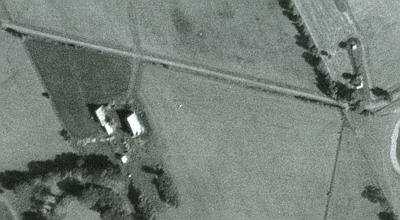
1964: the Bigford farm before rechanneling; the house, two barns and a shed are still in use
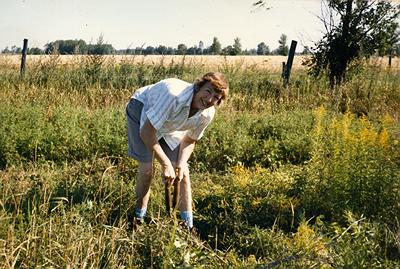
1985: Irene Woolford trimming 1 year old walnut seedlings
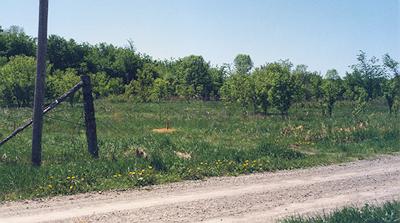
1991: the view west from the entrance
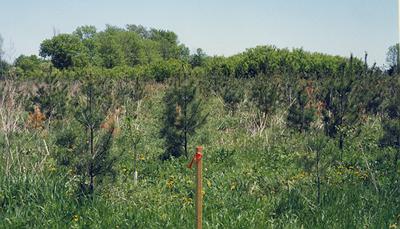
Manitoba maples seeding into the new SNC pine plantation
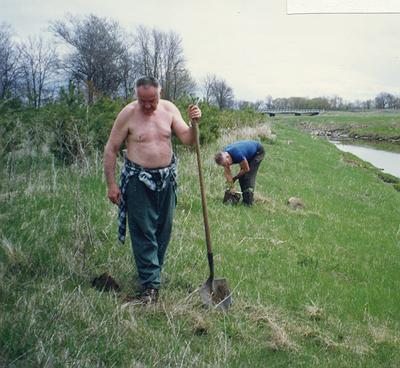
1992: the first attempt to stabilize the river bank: Ernie Kerr & George Truscott planting shrubs
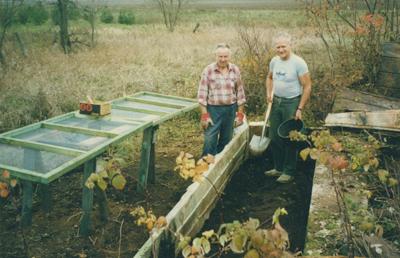
Ernie Kerr & George Truscott with their first seed bed
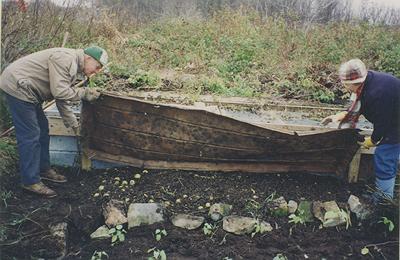
George Truscott & Irene Woolford uncovering stratified black walnut seed
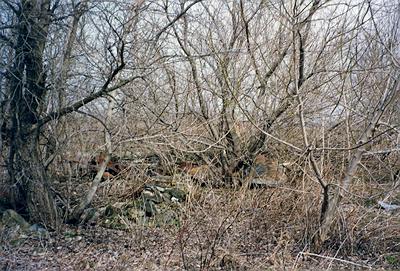
the Bigford barn foundation hidden by invading Manitoba maples
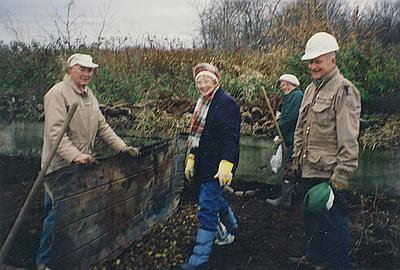
the nursery crew: Alex Jones, Irene Woolford, ?, George Truscott
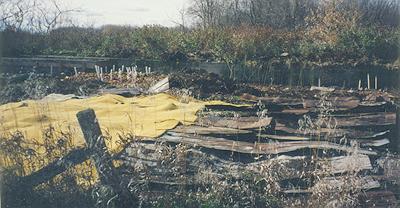
weed suppression in the nursery: Irene's old carpet and tin roofing
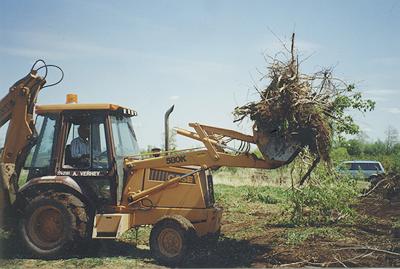
Adri Verhey ripping out Manitoba maples
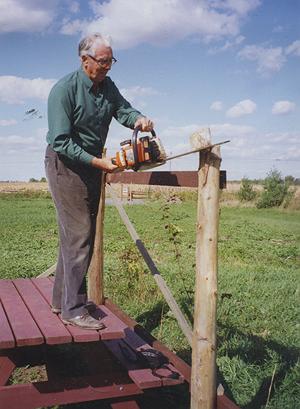
Ralph McKendry at work on the fence
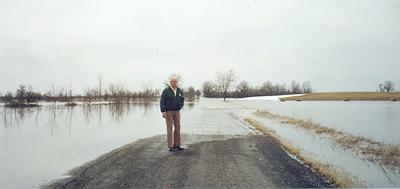
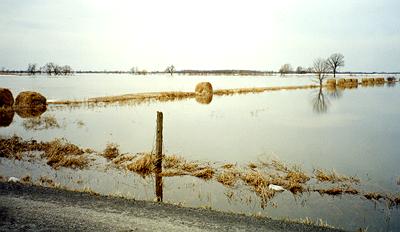
1993: the spring flood
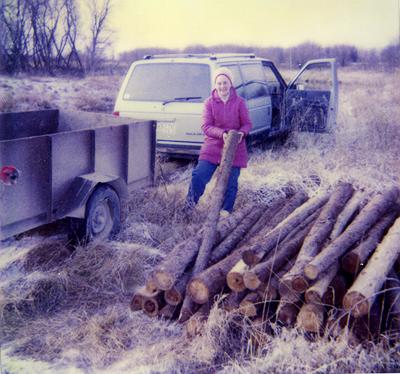
unloading posts for the nursery fence
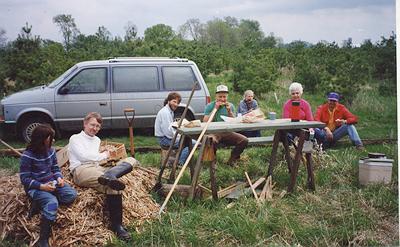
spring work crew: Heather & Steve Palmer, ?, George Truscott, ?, ?, ?
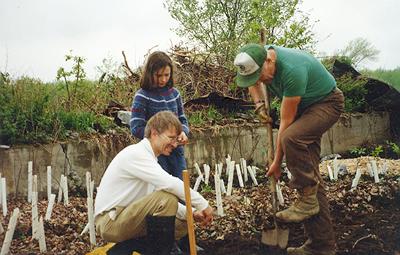
Steve & Heather Palmer, George Truscott moving seedlings
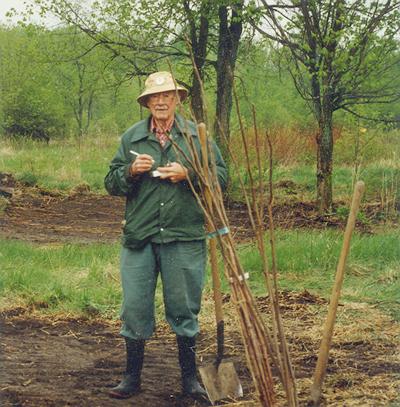
Alex Jones recording planting details
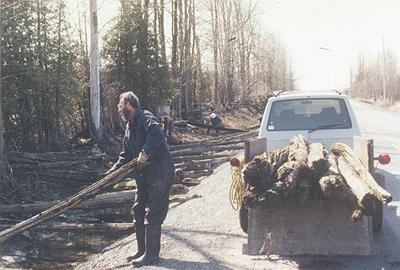
salvaging the 140-year old Stuart cedar rail fence
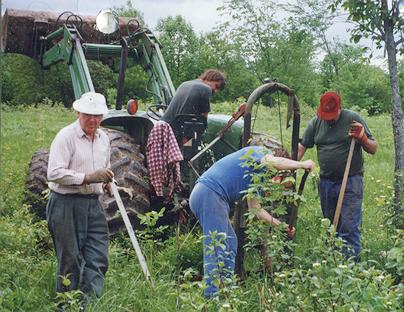
re-installing the fence at Oak Valley
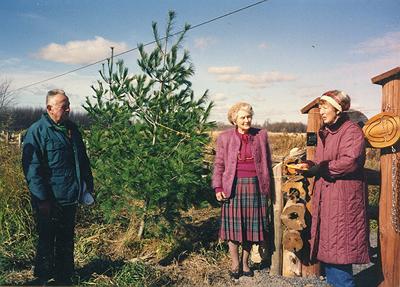
Ernie Kerr, Elizabeth Stuart, Irene Woolford dedicating the fence
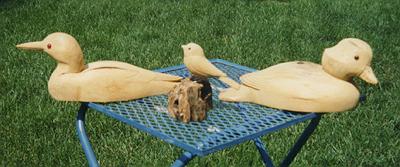
bird carvings from scraps of the fence by Ernie Kerr; one was presented to Elizabeth Stuart
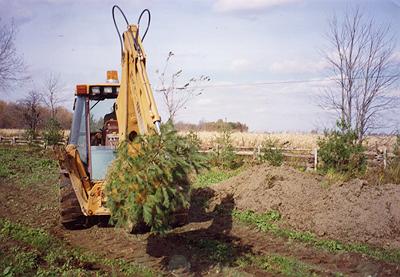
Adri Verhey moving pines for a shelter belt along the fence
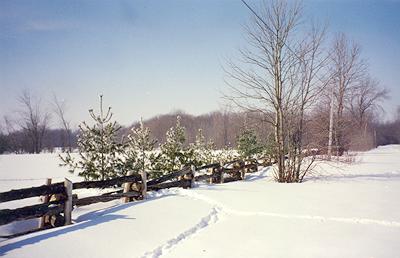
winter view of the fence and new shelterbelt
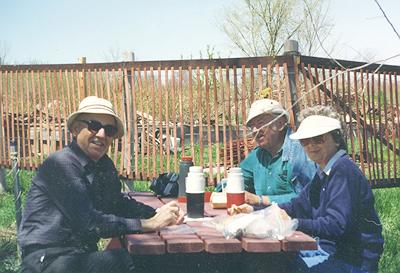
1994: Len Collett, Ernie Kerr, Genice Collett at lunch break beside the new nursery shelter fence
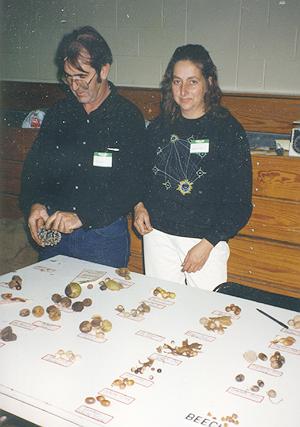
Ted & Isobel Cormier showing nuts they collected for Oak Valley
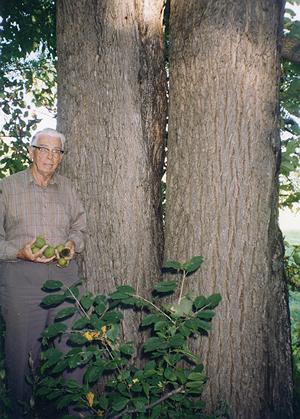
Ralph KcKendry and the black walnuts of Calumet Island
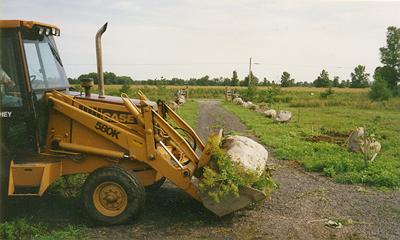
1995: Adri Verhey moving boulders to frame Oak Lane
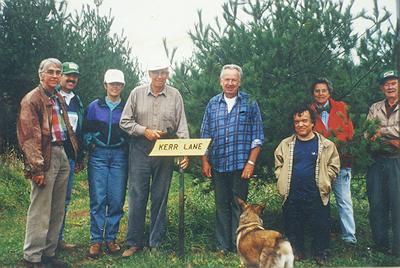
dedicating Kerr Lane: Bob McKendry, Lester McInnis, Josée Brizard, Ralph McKendry, Ernie Kerr, ?, ?, Alex Jones
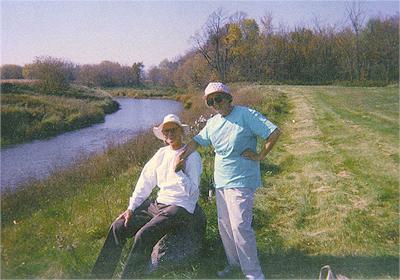
Michael & Irene Broad
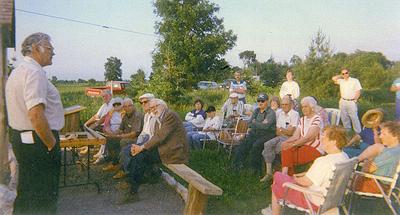
1996: official opening of the park: speaker Larry Grey, front row Estelle Rose, ?, Ralph McKendry, ?, Clarence Cross
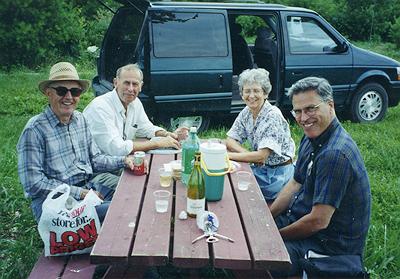
geologists Len Collett, Walter Fahrig (& wife), Peter Carr cataloguing the memorial boulders
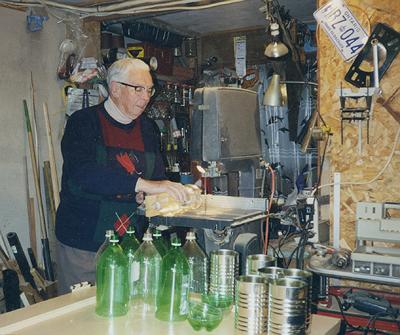
1997: Ralph McKendry's tree shelter factory
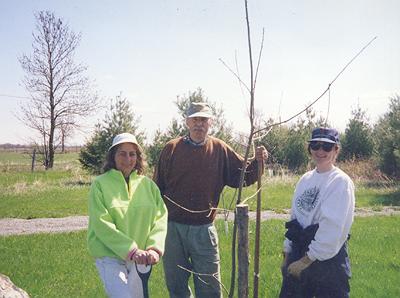
Isobel Cormier, Kurt Wasner, Barb Boysen planting English oaks from Kurt's nursery
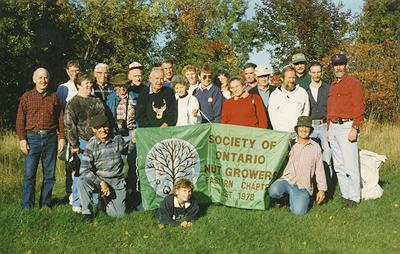
1998: SONG meeting
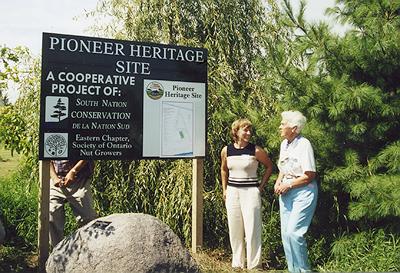
2000: the new entrance sign, unveiled by Mary Ann Wilson (SNC) & Myrtle McKendry
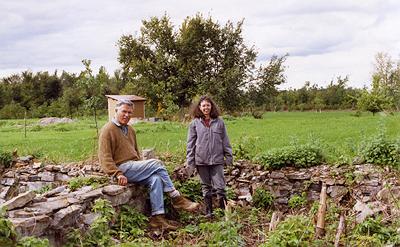
Peter Carr with Kim McInnis at the beginning of her Victorian garden in the barn outbuilding foundation
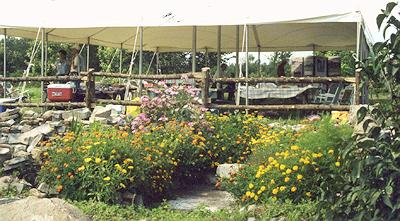
the garden in bloom on Volunteers' Day
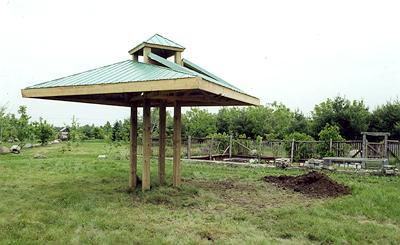
2001: the new picnic shelter
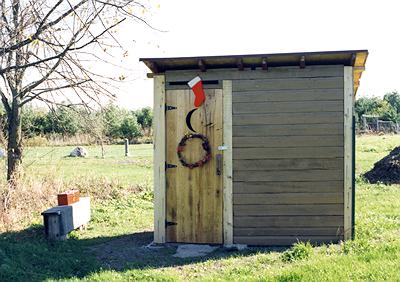
the new out house
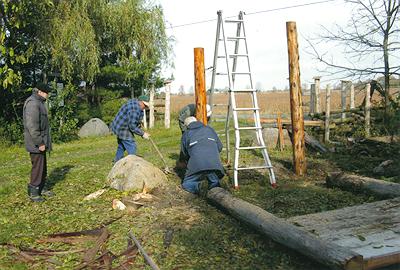
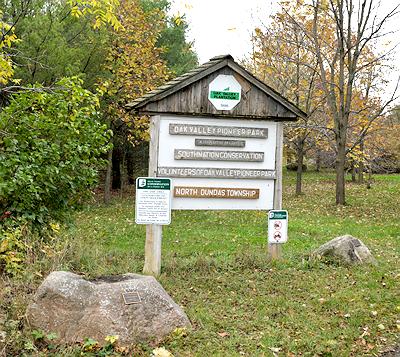
2009: installing new sign posts: Roman Popadiouk, Murray Inch, Barclay Cormack, John Sankey
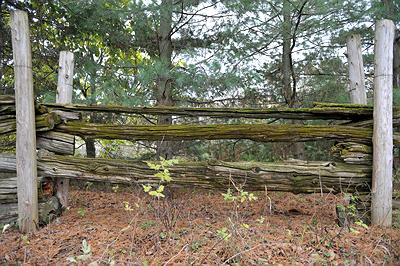
the Stuart fence after 15 years at its new location
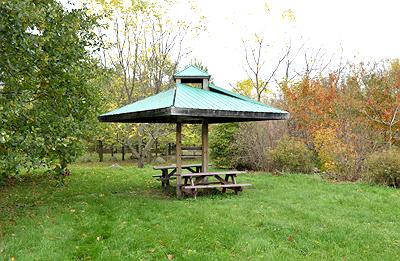
the picnic shelter after 10 years
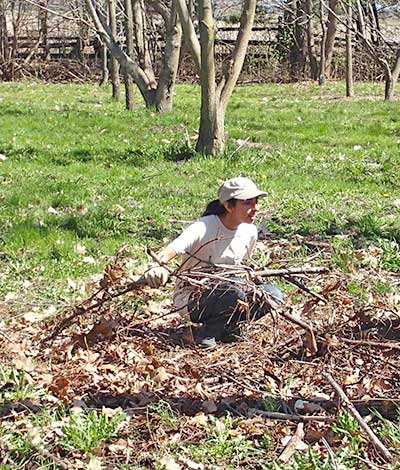
Mesha Sagram clearing black walnut trimmings spring 2016